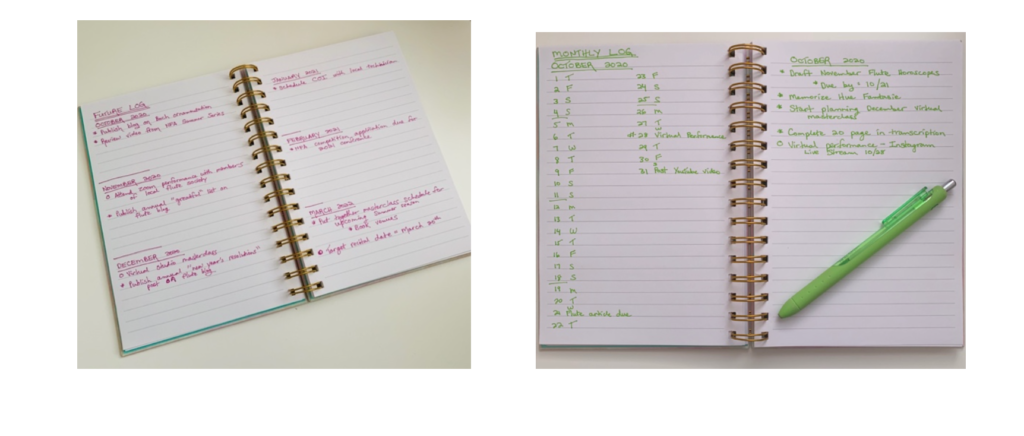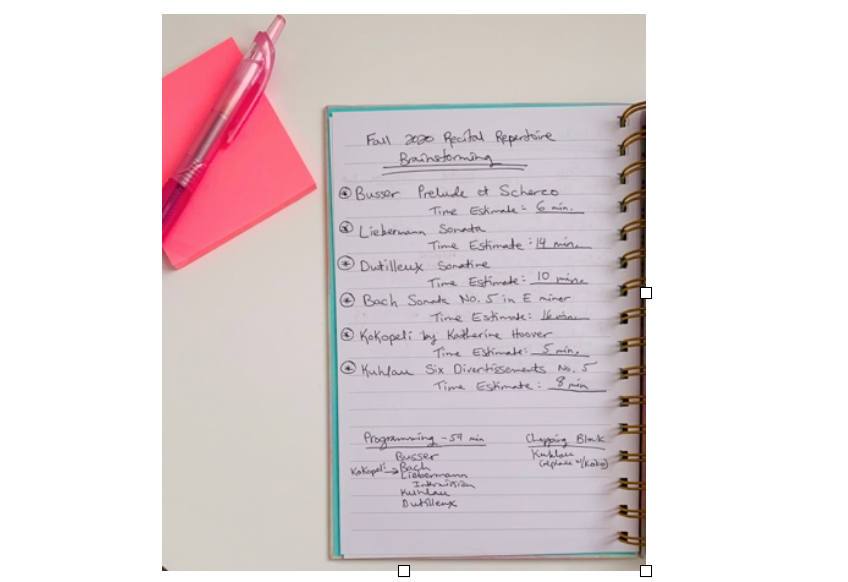Bullet Journals
by Rachel Taylor Geier
Over the past several months, our schedules and daily to-dos have become a bit unpredictable. This has encouraged many of us to reexamine how we organize our time in a changing environment. While some of us rely on old-school planners and others on digital calendars, a new method of organizing our lives has made its way into social media. The Bullet Journal, known to some simply as the BuJo, is a creative way to declutter our brains, seamlessly combining productivity with mindfulness. Created by Ryder Carroll, the Bullet Journal is used to organize information in the unique way that our minds work, allowing us to more effectively prioritize items as they relate to our specific needs. In an interview with Amanda Garrity and Lizz Schumer of Good Housekeeping Magazine, Carroll discusses the origins of the journal by explaining, “When I was young, I was diagnosed with ADD and there weren't a lot of tools or resources available, so I had to design my own. Rather than keep notes like other people, I figured out how to organize and sort information the way that my mind works." (“What is a Bullet Journal? Everything You Need to Know Before You BuJo,” Good Housekeeping Magazine, December 27, 2019). Above all, this type of journal offers supreme flexibility. For flutist who teach, perform, collaborate, and retain an active masterclass life, a Bullet Journal may just be the best way to streamline all to-dos in one place.
The Bullet Journal takes its name from the simplicity of the bullet-point. A typical journal contains at least four distinct sections, however other sections can be added depending on the needs of its owner:
- Index
- Future Log (4 pages outlining the year at a glance)
- Monthly Log (2 pages containing the most important tasks on specific days with a corresponding task page)
- Daily Log (1 page capturing the daily to-dos)

Items on each of these pages are recorded using a series of symbols known to bullet journalists as “rapid logging.” Rapid logging includes notations for tasks and events as well as task status:
Symbols:
- ï = Tasks
- o = Events
- - = Notes, ideas, observations
- * = Priorities
- ! = Inspiration (ideas/insights)
Task Status
- ï = Task incomplete
- X = Task complete
- > = Task migrated elsewhere (ex. another monthly log)
- < = Task scheduled in future log (ex. daily log)
Nesting is also encouraged within lists and logs. For example, if a larger task, such as recital planning, includes a number of different associated actions and related events, a nested table may be useful to streamline each step:
Recital Planning
X Select Repertoire
- Time each piece (approximate times okay)
ï Contact accompanist to schedule rehearsals
ï Book recital hall
ï Design programs
O = First rehearsal with accompanist (Monday, 10/10; 1:00 pm)

The term “migrating” refers to moving a task from one list to another. This typically occurs at the end of the month when reviewing which goals were accomplished and which still remain unfinished. Unfinished goals can be denoted with a < symbol and moved to your next monthly task list. This monthly ritual is a good way to review what is truly important from month to month and what can be removed from your task list (and your life).
Although Bullet Journals have been implemented in other industries, we have not yet examined their potential usefulness as productivity tools for flutists. The beauty of a Bullet Journal is in its flexibility. Additional sections can be added to a Bullet Journal to capture the individual projects and priorities of its owner. For a typical flutist, additional sections may include the following:
- Practice Trackers (Daily, Weekly, Monthly, Yearly)
- Practice Goal List (Yearly and/or Long-Term)
- Recital Planner
- New Techniques List
- Task Lists from Lessons (What do you need to accomplish by next week? What do your students need to accomplish by their next lesson?)
- Blog Post Ideas (and publication status)
- Capture List (List of any ideas that come up during masterclasses, presentations, lessons, etc.)
As of September 2019, Bullet Journals have been tagged in more than 8 million posts on Instagram. According to Anna Russell from The New Yorker, “It has taken off on the Internet as a kind of mindfulness-meets-productivity trend that equates organized journaling with an ordered interior life. It promises to help you achieve your goals and declutter your mind.” (“Can Bullet Journaling Save You?” The New Yorker, September 7, 2019). Perhaps Ryder Carroll explains it best in his subsequent interview with Ms. Russell, explaining, “I like to describe what I do as giving people an empty house that they fill with their own life…Only add what serves you, and be patient with yourself, because it’s a new thing. You’re not doing it right, you’re not doing it wrong, you’re just figuring it out as you go along.” (“Can Bullet Journaling Save You?” The New Yorker, September 7, 2019).
A Bullet Journal is a great way to collect all of your lists, calendars, and other productivity tools in once place and revise as needed. The flexible nature of this device allows us to change our priorities and tasks as we stay fit, particularly in light of the ever-changing circumstances of our world today. Nothing is predictable, but with a Bullet Journal we can add a bit of organization to our chaotic “New Normal”.
Rachel Taylor Geier holds a DMA in Flute Performance from the University of Minnesota-Twin Cities, an MM in Flute Performance from San Francisco State University, and a BM in Music Performance from DePauw University. Former applied instructors include Immanuel Davis, Linda Lukas, Anne Reynolds, and Rhonda Bradetich. Dr. Geier currently teaches and freelances in Davis, California.
